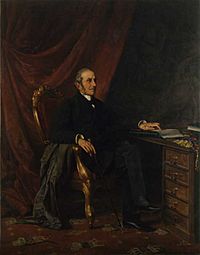Manuel Antonio Sanclemente facts for kids
Quick facts for kids
Manuel Antonio Sanclemente
|
|
|---|---|
 |
|
| 3rd President of Colombia | |
| In office August 7, 1898 – July 31, 1900 |
|
| Vice President | José Manuel Marroquín |
| Preceded by | Miguel Antonio Caro |
| Succeeded by | José Manuel Marroquín |
| Personal details | |
| Born |
Manuel Antonio Sanclemente Sanclemente
September 19, 1814 Buga, Valle del Cauca Department |
| Died | March 12, 1902 (aged 87) Villeta, Cundinamarca, Colombia |
| Nationality | Colombian |
| Political party | Conservative |
| Other political affiliations |
National Party |
| Spouse | Nazaria Domínguez |
| Alma mater | University of Cauca |
| Occupation | Lawyer, educator, politician |
Manuel Antonio Sanclemente Sanclemente was born on September 19, 1814, and passed away on March 12, 1902. He was a significant leader in Colombia's history. He served as the President of Colombia from 1898 to 1900.
Contents
Early Life and Education
Manuel Antonio Sanclemente was born in a town called Buga, located in the Valle del Cauca Department of Colombia. This was on September 19, 1814.
He went to the University of Cauca in Popayán to study law. He worked hard and finished his law degree in 1837. Later in his life, he died in Villeta, Cundinamarca, on March 19, 1902. At that time, he was under house arrest.
A Career in Politics
Sanclemente began his political journey by becoming a magistrate in 1854. A magistrate is like a judge in a high court, helping to make important legal decisions.
He also served in the government of President Mariano Ospina Rodríguez. During this time, he was in charge of two important roles:
- Secretary of Government
- Minister of War
He held these positions from April 1, 1857, to July 18, 1861.
Becoming President
In 1898, when he was 84 years old, Sanclemente decided to run for President of Colombia. He was part of the Conservative Party. His running mate, who would become Vice-President, was José Manuel Marroquín.
The election results were confirmed on July 4, 1898. Sanclemente and Marroquín won and were elected for a six-year term.
Taking the Oath
On August 7, 1898, the day he was supposed to become president, Sanclemente was not feeling well. Because he was sick, Vice-President Marroquín had to take the oath of office in his place.
A few weeks later, Sanclemente told the Senate he was ready to start his presidency on November 3, 1898. The House of Representatives disagreed with this date. They wanted him to start on November 5, showing they were not happy with him.
The Senate did not agree with the House. So, on November 3, Sanclemente decided to take his oath before the Supreme Court instead. A few days later, the House finally accepted that he was the new president.
The Thousand Days' War Begins
In October 1899, a major conflict began. The Colombian Liberal Party launched a huge attack against Sanclemente's government. This event marked the start of a very long and difficult civil war known as the Thousand Days War.
The fighting began in the Santander Department and quickly spread across the entire country. Many important generals led the Liberal forces, including Gabriel Vargas Santos and Rafael Uribe Uribe. On the government's side, conservative generals like Ramón González Valencia and Jorge Holguín fought to defend the country.
This civil war lasted for three years, until November 1902. It caused:
- Thousands of deaths
- Millions of dollars in losses
- Deep sadness and anger among the people
Both sides won and lost many battles. In the end, the conservative government was victorious.
The 1900 Coup d'état
On July 31, 1900, in the middle of the civil war, a significant event happened. President Sanclemente was very old and not in good health. He was finding it hard to lead the country during such a difficult war.
While Sanclemente was resting at his summer home in Villeta, a group of powerful politicians and military leaders met in Bogotá. They decided to remove him from office and place him under house arrest. Sanclemente was told about this on August 3.
Some of the important people involved in this change included future presidents of Colombia like Miguel Abadía Méndez and José Vicente Concha. Even Vice-President José Manuel Marroquín was part of this group.
See also
 In Spanish: Manuel Antonio Sanclemente para niños
In Spanish: Manuel Antonio Sanclemente para niños

